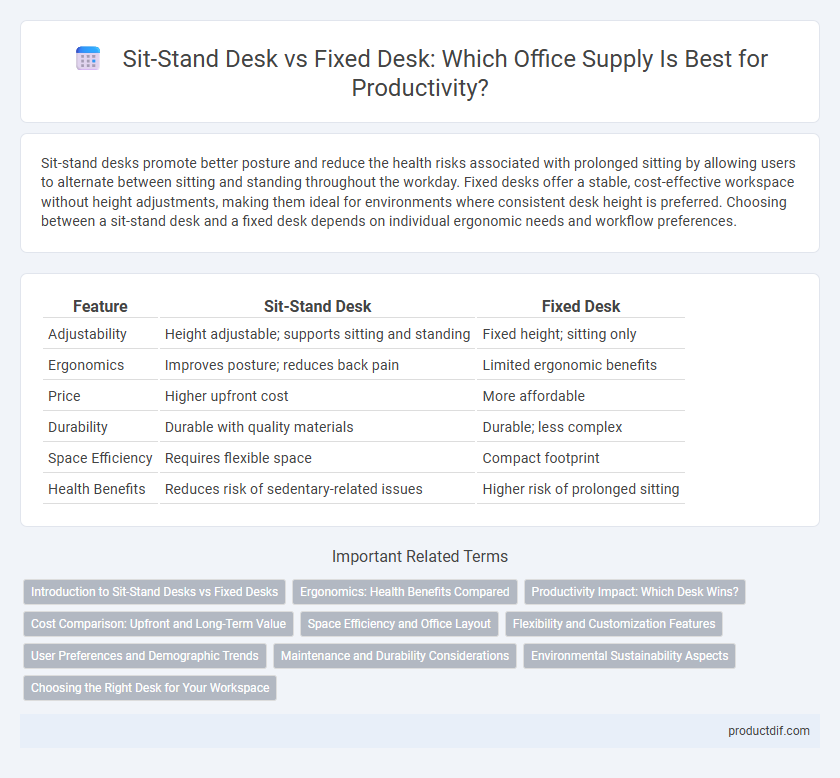Sit-stand desks promote better posture and reduce the health risks associated with prolonged sitting by allowing users to alternate between sitting and standing throughout the workday. Fixed desks offer a stable, cost-effective workspace without height adjustments, making them ideal for environments where consistent desk height is preferred. Choosing between a sit-stand desk and a fixed desk depends on individual ergonomic needs and workflow preferences.
Table of Comparison
| Feature | Sit-Stand Desk | Fixed Desk |
|---|---|---|
| Adjustability | Height adjustable; supports sitting and standing | Fixed height; sitting only |
| Ergonomics | Improves posture; reduces back pain | Limited ergonomic benefits |
| Price | Higher upfront cost | More affordable |
| Durability | Durable with quality materials | Durable; less complex |
| Space Efficiency | Requires flexible space | Compact footprint |
| Health Benefits | Reduces risk of sedentary-related issues | Higher risk of prolonged sitting |
Introduction to Sit-Stand Desks vs Fixed Desks
Sit-stand desks provide adjustable height options, allowing users to alternate between sitting and standing positions, which promotes better posture and reduces the risk of sedentary-related health issues. Fixed desks remain at a constant height, offering stability and simplicity but limiting ergonomic flexibility. Choosing between a sit-stand and a fixed desk impacts workplace comfort, productivity, and long-term health outcomes.
Ergonomics: Health Benefits Compared
Sit-stand desks promote better ergonomic health by allowing users to alternate between sitting and standing, which reduces the risk of musculoskeletal disorders and improves circulation. Fixed desks often contribute to prolonged sitting, increasing the likelihood of back pain, poor posture, and decreased energy levels. Incorporating sit-stand desks can enhance comfort, reduce fatigue, and support long-term spinal health in office environments.
Productivity Impact: Which Desk Wins?
Sit-stand desks significantly boost productivity by promoting movement, reducing fatigue, and improving focus compared to fixed desks. Research shows employees using sit-stand desks report higher energy levels and better task management throughout the workday. Ergonomic benefits combined with enhanced circulation contribute to sustained workplace efficiency and reduced downtime.
Cost Comparison: Upfront and Long-Term Value
Sit-stand desks typically have a higher upfront cost, ranging from $300 to $1,200, compared to fixed desks that generally cost $100 to $400. Long-term value of sit-stand desks includes potential health benefits such as reduced back pain and increased productivity, which can offset the initial investment over time. Fixed desks offer durable, low-maintenance solutions with less initial financial commitment but might incur higher health-related indirect costs.
Space Efficiency and Office Layout
Sit-stand desks maximize space efficiency by offering adjustable height options that accommodate various tasks without requiring additional furniture, enhancing flexible office layouts. Fixed desks occupy consistent floor space and can limit reconfiguration possibilities, often resulting in less adaptable office arrangements. Incorporating sit-stand desks supports dynamic space utilization, promoting ergonomic benefits while optimizing overall office footprint.
Flexibility and Customization Features
Sit-stand desks provide superior flexibility by allowing users to adjust height settings between sitting and standing positions, promoting ergonomic comfort and reducing sedentary behavior. Fixed desks lack this adaptability, offering a single, static height that limits customization for individual user needs. Advanced sit-stand models often feature programmable memory presets, customizable desktop sizes, and modular accessories, enhancing workspace personalization beyond the capabilities of fixed desks.
User Preferences and Demographic Trends
Sit-stand desks appeal strongly to health-conscious professionals aged 25-45, reflecting a growing preference for ergonomic and flexible work environments. Fixed desks remain popular among traditional office setups and older demographics who prioritize stability and simplicity. Market analysis shows a significant rise in sit-stand desk adoption in tech and creative industries, driven by wellness trends and remote work flexibility.
Maintenance and Durability Considerations
Sit-stand desks typically feature more complex mechanical components such as motors and adjustable frames, requiring periodic calibration and occasional part replacements to maintain optimal function. Fixed desks, often constructed with simpler materials and fewer moving parts, generally demand less maintenance and offer greater resistance to wear over time. Selecting between the two depends on balancing the need for ergonomic flexibility with long-term durability and maintenance costs.
Environmental Sustainability Aspects
Sit-stand desks contribute to environmental sustainability by promoting healthier work habits that can reduce the need for frequent office refurbishments and waste associated with fixed desks. Manufactured using eco-friendly materials like bamboo or recycled aluminum, sit-stand models often feature modular designs that extend product lifespan compared to conventional fixed desks made from particleboard or non-recyclable plastics. Incorporating energy-efficient production processes and the potential for resale or repurposing further enhances the eco-conscious appeal of sit-stand desks over traditional fixed options.
Choosing the Right Desk for Your Workspace
Choosing the right desk for your workspace requires evaluating factors like ergonomics, space, and work habits. Sit-stand desks offer flexibility by allowing users to alternate between sitting and standing, promoting better posture and reducing sedentary time. Fixed desks provide stability and often cost less, making them suitable for tasks requiring a consistent setup.
Sit-stand desk vs Fixed desk Infographic

 productdif.com
productdif.com